
Willows, also called sallows and osiers, of the genus Salix, comprise around 350 species of typically deciduous trees and shrubs, found primarily on moist soils in cold and temperate regions.

Salix alba, the white willow, is a species of willow native to Europe and western and central Asia. The name derives from the white tone to the undersides of the leaves.

Salix caprea, known as goat willow, pussy willow or great sallow, is a common species of willow native to Europe and western and central Asia.

Salix amygdaloides, the almond leaf willow or peach leaf willow, is a species of willow native to central North America east of the Cascade Range. It can be found in southern Canada and the United States—from western British Columbia to Quebec, Idaho, Montana and Arizona to eastern Kentucky. As of 2022, it is presumed extirpated from the state of Kentucky.
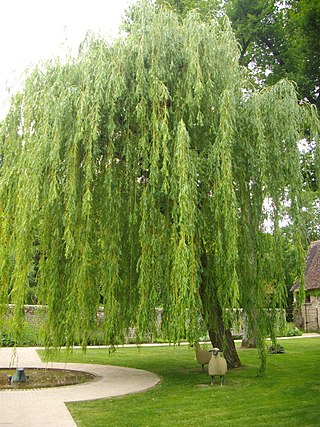
Salix babylonica is a species of willow native to dry areas of northern China, but cultivated for millennia elsewhere in Asia, being traded along the Silk Road to southwest Asia and Europe.

Salix nigra, the black willow, is a species of willow native to eastern North America, from New Brunswick and southern Ontario west to Minnesota, and south to northern Florida and Texas.

Salix lasiolepis is a species of willow native to western North America.
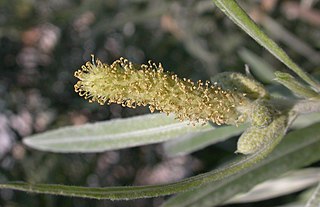
Salix exigua is a species of willow native to most of North America except for the southeast and far north, occurring from Alaska east to New Brunswick, and south to northern Mexico. It is considered a threatened species in Massachusetts while in Connecticut, Maryland, and New Hampshire it is considered endangered.

Salix myrsinifolia, known as the dark-leaved willow or myrsine-leaved willow, is a species of willow native to Europe and Western Siberia. It forms a 2–5 m (6.6–16.4 ft) high shrub. In the north it often becomes a tree up to 8 m (26 ft) tall.

Salix bebbiana is a species of willow indigenous to Canada and the northern United States, from Alaska and Yukon south to California and Arizona and northeast to Newfoundland and New England. Common names include beaked willow, long-beaked willow, gray willow, and Bebb's willow. This species is also called red willow by Native Americans according to The Arctic Prairies Appendix E by Ernest Tompson Seton.
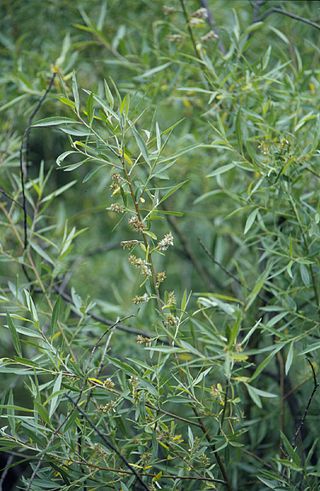
Salix geyeriana is a species of willow known by the common names Geyer's willow, Geyer willow and silver willow. The type specimen was collected by the botanist Karl Andreas Geyer, for whom it was named. Its conspicuous, yellow flowers begin to bloom as early as March, to as late as the end of June.

Salix alaxensis is a species of flowering plant in the willow family known by the common names Alaska willow and feltleaf willow. It is native to northern North America, where it occurs throughout Alaska and northwestern Canada.

Salix arbusculoides is a species of flowering plant in the willow family known by the common name little tree willow. It is native to northern North America, where its distribution extends across Alaska and most of Canada.
Salix brachycarpa is a species of flowering plant in the willow family known by the common names barren-ground willow, small-fruit willow and shortfruit willow.
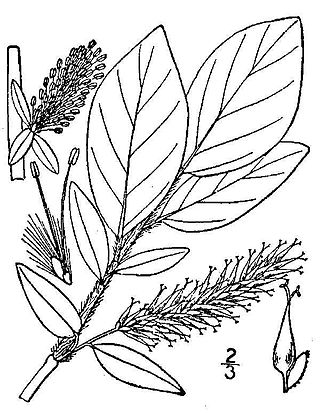
Salix barclayi, or Barclay's willow, is a species of willow native to North America, found primarily in the Northwestern area of the United States and Canada. It grows near lakes and streams at elevation. It is a shrub, that can grow up to 2.5 m. (8 ft.) tall and tends to be slender. Leaves are elliptic to obovate, 2–6 cm long and 1–2.5 cm wide. Leaves are hairy when young, with midrib hairs lasting into maturity. Catkins are on short, leafy peduncles. Staminate catkins are 3 cm long with 2 stamens, while pistillate catkins are 2.5–5 cm long and glabrous.

Salix humboldtiana, called Humboldt's willow, is a tree species of willow native to North and South America, growing along watercourses. Some authorities consider it a synonym of Salix chilensis, which Molina described in 1782. Willdenow described Salix humboldtiana in 1805.

Salix irrorata, the dewystem willow, blue-stem willow, or sandbar willow, is a species of willow native to the US states of Wyoming, Colorado, Arizona, and New Mexico, and to northern Mexico. In spite of its bluestem willow common name, its stems are red, but a white coat develops that makes them appear bluish. A bushy shrub that prefers moist areas, in a garden setting it needs coppicing to both keep it from growing overlarge and to maintain the attractive bark coloration. It has gained the Royal Horticultural Society's Award of Garden Merit as an ornamental.
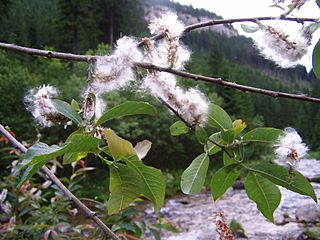
Salix silesiaca, the Silesian willow, is a species of flowering plant in the family Salicaceae. It is native to the Sudeten and Carpathian Mountains, and the mountains of the Balkan Peninsula. A shrub reaching 6 ft (2 m), it is considered to be a member of the informal sallow group.
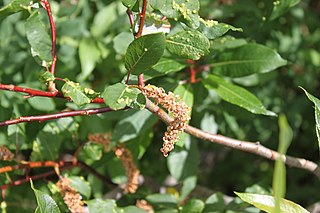
Salix pyrifolia, the balsam willow, is a species of flowering plant in the family Salicaceae, native to Canada, and the north-central to northeastern United States. A shrub, its leaves emit a balsam-like fragrance. It is available from commercial suppliers.

Salix excelsa is a species of flowering plant in the willow family Salicaceae. It is native to the Caucasus, Central Asia, Iran, Afghanistan, and Pakistan, and has been introduced to the Levant, Yemen, the Himalayas, and India. It is closely related to Salix acmophylla. It is used as a street tree in Georgia and Iran.




















